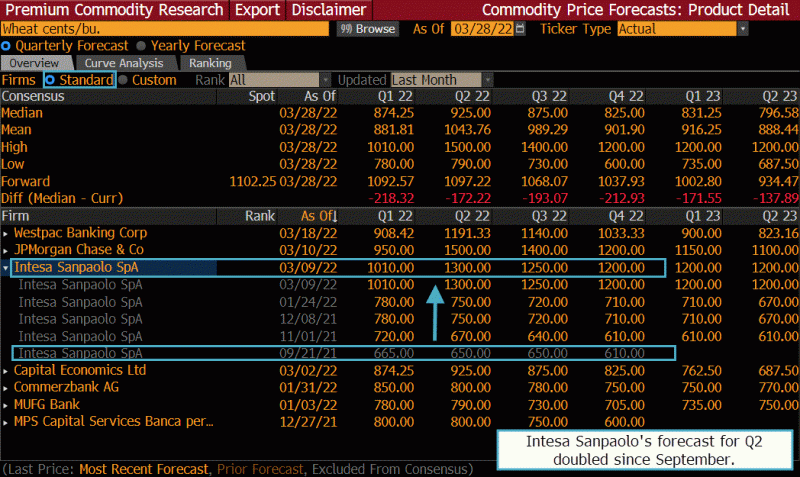Wheat to stay higher longer than oil, forecasts and futures show
Bloomberg Market Specialist Andrew Sparey contributed to this article. The original version appeared first on the Bloomberg Terminal.
Background
The Russian invasion of Ukraine has disrupted the flow of commodities worldwide, leaving buyers scrambling to source crucial materials needed for transporting goods and people, food production, manufacturing and powering cities. Russia is the world’s second-largest exporter of crude oil, earning more than $1 billion a day from its oil and gas exports. When combined with Ukraine, the two countries make up about a quarter of the global grain trade.
Oil prices were expected to decrease this year from 2021 with increased global supply, but they have instead risen sharply, leading U.S. President Joe Biden to release record amounts from reserves to help curb pump prices, which in March reached their highest levels since 2008. Meanwhile, OPEC is sticking with a gradual and more moderate increase in production.
Even before the war in Ukraine, food prices were on the rise globally due to increased shipping and energy costs, extreme weather and the labor shortages stemming from the pandemic. Food prices are at record highs, as a benchmark UN index rose more than 40% in the past two years. The culmination of war in one of the world’s major breadbaskets, sanctions against Russia, limited ability to export Ukrainian crops and steps taken in some countries to protect local food supplies have raised alarms over the possibility of severe food shortages, with the poorest countries being the most at risk.
The issue
Fast-moving events like the outbreak of war in Ukraine and resulting sanctions against Russia can affect long-term forecasts for already tight commodity markets. The evolution of individual commodity forecasts from past months illuminated how Russian President Vladimir Putin’s invasion of Ukraine shaped price expectations. In September, Brazilian bank Intesa Sanpaolo forecasted wheat at 650 cents/bushel in the third quarter of 2022 but has since doubled that forecast.
West Texas Intermediate crude could remain near current prices in the second quarter, while wheat may surge an additional 13%, according to bank estimates updated since Russia’s invasion of Ukraine. By the end of 2022, forecasts have WTI crude declining more than twice as quickly as wheat, and forward contracts are pricing in a faster decline for oil prices than wheat through the first half of 2023.
Tracking
Bloomberg functions revealed how commodity forecasts have jumped due to the war in Ukraine.

For more information on this or other functionality on the Bloomberg Professional Service, click here to request a demo with a Bloomberg sales representative. Existing clients can press <HELP HELP> on their Bloomberg keyboard.